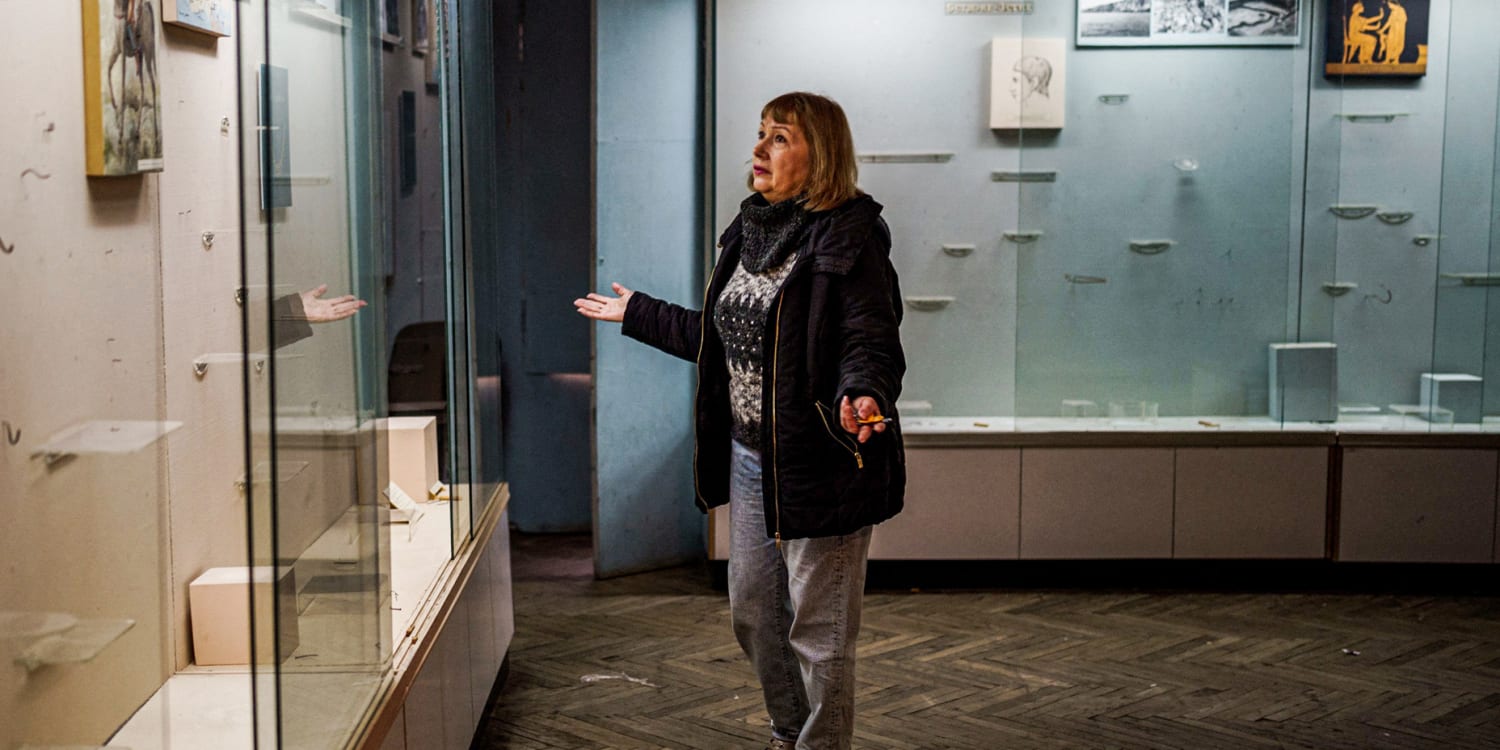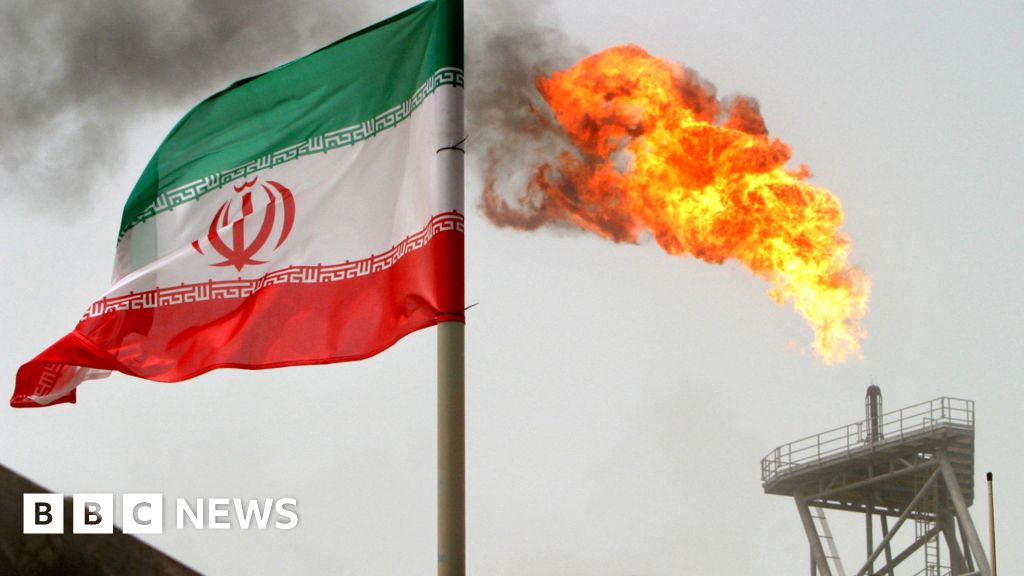
Last fall, Ukrainian forces were closing in on taking control of Kherson, pushing back the Russian forces that had captured the city after Moscow launched its invasion of Ukraine.
At the Kherson Regional Art Museum, a team of armed Russians in civilian clothes arrived with a large number of them Trucks and buses. Over the course of five days, they transported more than 11,000 art objects, including paintings, sculptures, drawings and other works, from Ukraine and around the world, said Alina Dotsenko, director of the museum.
“It was clear that everything was planned. The decision to loot the museum was not taken immediately,” Dotsenko said. “It was carefully planned.”
The theft, which has been verified by human rights monitors and independent scholars, was not an isolated incident.
A growing body of evidence suggests that Russian forces are systematically stealing art and cultural works from Ukraine on a scale not seen in Europe since Nazi looting in World War II, according to researchers and experts who have documented the damage.
Researchers said the theft includes precious fourth-century BC gold jewelry, ancient coins and thousands of paintings from museums and private collections. Some artistic and cultural sites have been seriously damaged and destroyed, including Christian Orthodox churches, libraries and centuries-old paintings by one of Ukraine’s most beloved artists, Maria Primachenko, whose work was hailed as a “miracle of art” by Pablo Picasso.
Experts said the orchestrated campaign of looting and destruction, targeting hundreds of cultural monuments, churches and museums, appears to be aimed at erasing Ukraine’s history and cultural identity.
Before ordering the invasion of Ukraine on February 24, 2022, Russian President Vladimir Putin had repeatedly argued that the idea of a separate Ukrainian national identity was a fantasy, that Ukraine lacked a “real state” and that it was part of Russia’s “own history, culture and spiritual space.”
“They are trying to erase Ukrainian identity, just like the Nazis did,” said Chris Marinello, an art compensation attorney and founder of a firm to restore stolen and looted art.
“Putin’s forces have bombed, bombed, and destroyed hundreds of sites and places that embody Ukrainian identity and heritage—from churches and museums to archaeological sites and monuments,” said Richard Coren, Ambassador-at-Large for the Smithsonian Institution.
“He seeks to remove the material signs of Ukraine’s distinctive culture in order to conform to his distorted view that no such culture exists.”
The Russian embassy in Washington did not respond to a request for comment.
In some cases, museums or other cultural sites far from any front line have been targeted, according to satellite imagery and researchers on the ground.
A few days after the February 24 invasion, the Ivankiv Historical and Local History Museum near Kiev was bombed, although it was not near any combat or military targets, according to the researchers. The bombing started a fire that destroyed and damaged many of Primachenko’s works, which were his vivid and imaginative paintings of animals. Inspired Painter Marc Chagall.
Kathryn Hanson, chief of research for the Smithsonian’s Cultural Rescue Initiative, said the attack on the Ivankiv Museum is part of a pattern of “targeted destruction” of cultural sites.
Hanson said that the theft of priceless works of art in areas captured by Russian forces cannot be explained as random or spontaneous actions by Russian soldiers.
“Our research indicates that this looting is sponsored by Russia,” Hanson said.
Hanson is one of the authors of a report due out this month by the Smithsonian Cultural Rescue Initiative that examines the looting of cultural heritage in Ukraine since the Russian invasion.
In a modern version of the World War II-era effort to save art treasures from German plunder depicted in the Hollywood movie “Monuments Men,” Hanson is part of a team of archaeologists, historians, satellite imagery experts and other scholars trying to document the assault on cultural sites in Ukraine.
Using satellite imagery, thermal imaging, artificial intelligence tools, and research on the ground, the US-funded Smithsonian team can sometimes verify an accident within hours after it occurs, said Susan Wolfenbarger, a team leader in the US State Department office. Advanced analytics.
“We’re really leveraging new technologies, new data feeds, to help us both document these things but also to do it quickly and at a scale that hasn’t been attempted before,” Wolfenberger said.
It said that using a database of more than 28,000 cultural sites in Ukraine, the Smithsonian team was able to detect an attack on the museum in Ivankiv through a combination of thermal imaging from NASA and commercial satellite imagery.
The Smithsonian Initiative is part of a broader 6 million dollars An effort funded by the Biden administration — including a variety of US think tanks — to collect evidence for potential international war crimes investigations.
Russian forces targeted cultural monuments earlier in the conflict, after they seized Crimea and parts of eastern Ukraine more than eight years ago, said Matthew Steinhelfer, deputy assistant secretary for the State Department’s Office of Conflict and Stabilization Operations.
“We’ve seen this evidence before,” he said. “We’ve seen this since 2014, as Russia removed artifacts, demolished cemeteries and closed churches in the Donbass region and Crimea.”
The 1954 Hague Convention prohibits militaries from targeting and looting museums or other cultural sites. In war crimes trials in conflicts in the former Yugoslavia and Mali, international prosecutors have won convictions which cited attacks on religious and cultural monuments.
As of March, UNESCO said it had verified the damage to 248 cultural figures sites In Ukraine, including 107 religious sites and 12 libraries.
“We have a list of verified damages, and the numbers just keep growing,” said Krista Breccat, UNESCO’s Director for Culture and Emergencies.
The World Bank recently estimated that the cost of the program Damage To date, cultural buildings and art collections of Ukraine from the invasion amount to almost $ 2 billion.
International cultural organizations and Interpol are warning authorities across Europe and around the world not to search for art stolen from Ukraine. The International Council of Museums has issued an “emergency red list” of artworks at risk, which UNESCO is now using to train border officials in other countries, UN officials said.
Last year, US Customs and Border Protection officials seized three ancient swords dating from the fifth or sixth century, as well as an ancient stone ax head, at New York’s JFK Airport, all of which had been stolen from Ukraine. They were returned to the government in a to celebrate Last month at the Embassy of Ukraine in Washington.
When Ukrainian art and artifacts are looted, Russian forces are often aided by Russian experts who travel to captured lands and know the country’s art collections, experts inside and outside Ukraine say.
“There are groups of experts who have been specially commissioned to come to Ukraine,” said Ihor Poshvelo, a Ukrainian curator who was trained by the Smithsonian staff before the invasion.
“They were looking for historical objects,” said Poshvelo, co-founder of the Heritage Emergency Response Initiative, which is trying to help repair and preserve Ukraine’s cultural heritage collections.
inside the job
Sometimes Ukrainians collaborating with the occupying Russian forces helped to loot.
After Russian forces captured Kherson in March last year, Alina Dotsenko and her colleagues fabricated an elaborate lie to try to protect the paintings and sculptures in the city’s art museum. They told the Russians that the museum was being renovated and the art collection had been removed.
For several months, Dotsenko said, the trick worked. But many Ukrainians allied with the occupying forces give up their secrets, and the Russians eventually learn that the art is still in the building, hidden in a storage area.
Prior to the fall of Kherson, Dotsenko had backed up the museum’s collection’s electronic inventory and removed any record of it from the building. But later she learned that a former colleague had also made a copy of the archive and given it to the Russians.
Shortly after the convoy of Russian trucks left the museum laden with thousands of artworks in November, photos Back Pointing out that the trucks arrived at a museum in the Russian-occupied Crimea.
Director of the “Central Museum of Taurida” in Simferopol, Andrei Malgin, I confess to Radio Free Europe that much of the Kherson Art Museum’s holdings are now in Simferopol.
He said the artworks were being stored to protect them. These are not our paintings. We understand this very well. There is no attempt on our part to advertise that they will remain with us or that we will display them. Malgin said.
Now Dotsenko and other museum staff are working to account for exactly what was moved, even as Kherson continues to be bombed by Russia.
A rare book in the museum’s collection, by one of Ukraine’s most famous poets, was rescued before the building was ransacked.
While the Russian occupation authorities were purging most of the museum’s staff, 66-year-old Galina Aksyutina, who supervised the library, took one last look at the collection. She spotted an 1894 edition of Kobzar by Taras Shevchenko, whose writings were censored by the Russian Empire in the 19th century and is now seen as the foundation of modern Ukrainian literature.
“I felt so sorry for this book. I thought this would be the first thing they would destroy because of its symbolic meaning, because they are destroying everything Ukrainian,” she said.
She decided to hide the book under her clothes.
“When I was leaving the museum, I was nervous. The Russians looked through all my personal belongings, but they didn’t search me personally, so they didn’t notice the book I had pulled out.”
She said the book was now safely returned to the museum.

“Travel specialist. Typical social media scholar. Friend of animals everywhere. Freelance zombie ninja. Twitter buff.”

:quality(85)/cloudfront-us-east-1.images.arcpublishing.com/infobae/FWZPCXC6Q4SMTSJFB7WTZUD4GE.jpg)



More Stories
Israel strikes Iran, but scope appears limited: live updates
Hossein Amir Abdollahian: Iran’s response will be “immediate and at the maximum level.” The Foreign Minister warns Israel
Trump and Polish President discuss NATO members increasing their defense spending